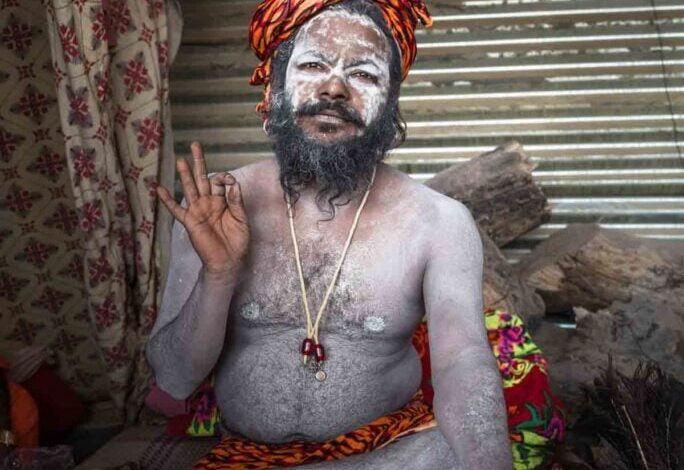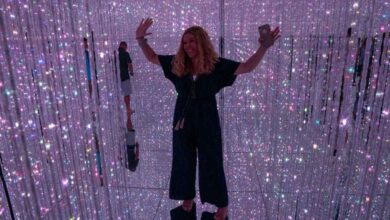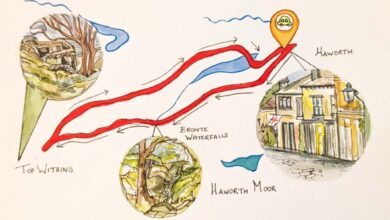The Maha Kumbh Mela 2025 in Prayagraj, India

For the last three weeks I have been here in Prayagraj, India photographing the Maha Kumbh Mela.
The Kumbh Mela is the largest religious gathering in the world, drawing millions of pilgrims and visitors to India’s sacred confluence of the Ganges, Yamuna, and the mythical Sarasvati River in Prayagraj.
By the time it finishes on the 26th February 400 million people are expected to have visited the site and taken a sacred dip at the confluence of these rivers. On the special bathing days around 40 million people maybe on site ‘at one time’. That’s 200 Glastonburys!

In this article I will discuss not only my experience of it but also the background and history to this massive gathering. Also I provide a guide on capturing it with photography.
What Is The Kumbh Mela
The Kumbh Mela, held every 12 years in India, the largest religious and cultural gathering in the world, drawing millions of people to bathe in the sacred waters.

However, this year’s Kumbh Mela is the Maha (Big) Kumbh Mela – that only happens every 144 years – the timing is the Kumbh Melas are linked to Jupiter’s orbit around the sun which takes 12 years. And when Jupiter enters the constellation of what in the Western world is Aquarius but in Indian mythology is referred to as Kumbh (a pitcher or jug).
The Kumbh Mela’s significance is deeply rooted in Hindu mythology, and its origin is tied to the cosmic struggle between the gods (Devas) and the demons (Asuras) for the Amrita (nectar of immortality).
The Mythological Background
The story behind the Kumbh Mela is found in the Samudra Manthan (Churning of the Ocean) from Hindu texts like the Bhagavata Purana, Vishnu Purana, and the Mahabharata.

The Churning of the Ocean (Samudra Manthan)
The gods and demons decided to cooperate to churn the Ocean of Milk (Kshir Sagar) to obtain Amrita, the nectar of immortality. The demons, led by the mighty King Bali, and the gods, led by Lord Indra, used Mount Mandara as the churning rod and the serpent Vasuki as the rope to churn the ocean.
The Appearance of Amrita
After a long and difficult process, the Amrita finally emerged from the churning. As the nectar was being distributed, a fierce battle broke out between the gods and demons over who would get the first share.

The Escape of Amrita
In the chaos, the god Vishnu took the form of the enchanting Mohini (a beautiful woman) and distracted the demons, allowing the gods to drink the nectar. As the gods fled with the Amrita, four drops of it fell at four different locations: Prayagraj (on the confluence of the Ganges, Yamuna, and the mythical Sarasvati rivers), Haridwar, Ujjain, and Nashik. These are considered the four sacred locations of the Kumbh Mela.
The Kumbh (Pitcher)
The name Kumbh refers to the pitcher that contained the Amrita. The myth of the Kumbh Mela is a reminder of this celestial event, symbolizing the struggle for immortality and divine grace. The gathering at these locations during the Kumbh Mela is believed to cleanse the soul and provide spiritual liberation (Moksha).

Significance of the Kumbh Mela
Spiritual Cleansing
The act of bathing in the holy waters at the Kumbh Mela is said to wash away sins and confer spiritual benefits, including purification of the soul and liberation from the cycle of birth and death (Samsara).

Rituals and Religious Fervour
The festival is also marked by rituals, prayers, and the participation of many ascetics, sadhus, and saints, who gather to offer blessings and spiritual guidance. The Mela serves as a reminder of the importance of devotion, penance, and the search for spiritual truths.
Cultural and Social Gathering
Beyond its religious significance, the Maha Kumbh Mela is also a massive cultural event, with people from all walks of life coming together to celebrate and engage in spiritual discourse, religious rituals, and cultural exchange.

The 2025 Maha Kumbh Mela
The 2025 Maha Kumbh Mela will be held in Prayagraj, from 14th January to 26th February 2025. The event is expected to be grander than the regular Kumbh Melas, with hundreds of millions of devotees, pilgrims, and tourists attending.
It will be a time of intense religious fervour, with elaborate rituals, holy processions, and a sense of collective devotion that will fill the air.

A European’s experience of the Kumbh Mela
I’ve been at the Kumbh Mela for three weeks now. At first it was completely over-whelming. The 14th January (the Full Moon) was the first big Royal Bathing Day when the Naga Sadhus (the naked warrior class of Sadhus) parade down to the confluence ‘nose’ and bathe.

I was right in the thick of the crowd of around 17 million people. I did manage to get some reasonable photographs of the Naga’s as the rushed past. But I couldn’t get to the water side.
I’ve then spent the days wandering the 4000-hectare site – photographing the sadhus and the pilgrims. Some of the Sadhus are performing austerities to express their devotion to Shiva.
One or two have held the arm in the air for years (decades?) until it has atrophied. Some have been standing and never siting down – even to sleep – for decades.
Others have large elaborate bead headdress on that weight 30 or 40 kilos. The Naga Sadhus have relinquished all worldly goods – including their clothes.


Normally Nagas are hard to find as they live in remote places – caves or the like – high in the Himalayas or in the forests. But at Kumbh they are everywhere dispensing blessings to pilgrims. I even managed to photograph a few of the feared aghori sadhus a sub-sect.
The Aghoris are thought to engage in macabre rituals, often dwell in cremation grounds and smear cremantion ash on their bodies, and use bones from human corpses for crafting skull cups and jewellery.
They area also rumoured to practice post-mortem cannibalism, eating flesh from foraged human corpses, including those taken from the cremation grounds. Whether all that is true or not I don’t know – but I didn’t hang about in their camp!

The best description I can come up with is that the Kumbh is little a really, really big Glastonbury, with an equally huge London protest march in the middle of it and then Blackpool beach on a sunny Bank Holiday Monday packed with people on the edge….. but believe me when I say that that does not do it justice!
The tent city goes on and on – within which there are camps of Sadhus and Gurus ‘touting’ for business like some massive trade fair for redemption.
On the next big bathing day (the 29th January – the New Moon) the crowd was even larger. This was the big one – likely to be the largest single gathering of humanity ever.
I, rather stupidly as it turned out, tried to go to the sangam (the confluence). I walked for about 3 hours from my homestay to get there.
Arriving around midnight or 1.00 am. As I tried to make my way to the waterside the crowd just got bigger and bigger until you couldn’t move. I decided that was too much and backtrack to near one of the temporary police stations that have been set up.

I laid down in the dust to try and get a few hours kip before dawn (as millions of other Indians were doing) hoping that my spot near the police station would keep me safe. After a few hours of being cold, uncomfortable and not really sleeping at all I tried again to get to the section of the confluence area where the sadhu parade would come through at around 6.00 am.
However, the area that should have been closed off for the sadhus was open and nothing seemed to be happening. There was loud tanoy announcements in Hindi and eventually I bumped into a Times of India reporter and her camera man who told me there had been an incident and people had been crushed and maybe even killed.
At that point ambulances came passed – and although the incident had happened at 1 am ish – they were still coming though the crowds to the water side and then returning.

At that point I thought I’d best get out of there – there was nothing I could do – so I walked the 8 to 10 kms back to my Homestay to sleep. I found out later at least 30 people had lost their lives.
Tragic though that was I have to say that generally the organisation of the whole event has been fantastic. Imagine building a 4000 hectare city to house tens of millions of people – roads, electric, water, toilets, mobile services, police stations, rubbish collection, road sweeping, health clinics etc etc – all in 12 weeks – hosting the world’s biggest gathering of humanity ever and then taking it all down again before the monsoon rains start and the river swells covering the site. Awesome.

Scheduled for early 2025, the event offers photographers a once-in-a-lifetime opportunity to capture powerful, spiritual, and awe-inspiring moments. With preparations for the grand event already underway, here’s a guide on how to approach photographing the Maha Kumbh Mela in 2025.
A Guide To Photographing The Maha Kumbh Mela
Understanding the Significance of the Maha Kumbh Mela
The Kumbh Mela is a festival where Hindus gather to bathe in the holy rivers, believed to purify the soul and erase sins. The Maha Kumbh Mela is the most auspicious, held once every 12 years. The 2025 Mela in Prayagraj will see devotees from all corners of India and the world, including sadhus (holy men), pilgrims, and tourists.

As a photographer, it is essential to understand the spiritual and cultural significance of the event to approach your subjects with respect and sensitivity.
Planning Your Visit: Timing and Logistics
The Kumbh Mela takes place over the course of several weeks, with the major bathing dates known as “Shahi Snan” attracting the highest number of pilgrims. The 2025 dates are expected to span from January to March, with the most significant bathing dates occurring in February.

Shahi Snan: The royal bath, when the most revered sadhus enter the river first, is one of the most photogenic moments of the festival. Dates like Makar Sankranti (mid-January), Mauni Amavasya (mid-February), and Basant Panchami are crucial for capturing this event.
Sunrise and Sunset: These times provide excellent lighting for photographing the Mela’s vast landscapes, rituals, and intimate moments. The early morning fog along the riverbanks can add a mystical aura to your shots.
The Right Gear for the Mela
Photographing the Kumbh Mela requires versatile and durable equipment. Here’s what you need:
Camera: A DSLR or mirrorless camera with high ISO capabilities for low-light conditions (early mornings and evenings) is essential. A full-frame camera is ideal for capturing wide-angle shots of the large crowds and intricate details of the festival.
Lenses: A wide-angle lens (16-35mm) is great for capturing the vast scale of the festival and landscapes. A mid-range zoom (24-70mm) is perfect for street photography, portraits, and candid moments. For close-up portraits or intimate scenes, a telephoto lens (70-200mm) can help you isolate details without disturbing the subjects.
Tripod: The Mela is a place of high energy, and while handheld shots are common, a tripod can be invaluable for long exposure shots of the river or the crowds.
Waterproofing: Given the large bodies of water around, protective covers for your camera gear are crucial to prevent damage from the humidity or accidental splashes.
Respect for the Subjects: Approaching the People
The Kumbh Mela is a deeply spiritual event for many participants, so it’s important to approach your subjects with respect and awareness. Pilgrims, sadhus, and locals often welcome photography, but it’s important to always ask for permission before taking close-up shots, especially of individuals in religious rituals.

Sadhus: Many sadhus, with their long beards, ash-covered bodies, and deep stares, are captivating subjects for portraits. However, sadhus are often deeply spiritual, and they may not always want to be photographed. A polite request for a photo, sometimes with an offering or donation, is often appreciated.

Candid Moments: The strength of the Mela is in its human element. Capturing the devotion, emotion, and excitement of people bathing, praying, and participating in rituals creates a powerful narrative. Focus on the little moments — the hands of a devotee in prayer, the look of serenity in someone’s face as they immerse themselves in the water, or the intensity of a sadhu’s gaze as he meditates.
Capturing Rituals and Traditions
A major part of the Kumbh Mela is the sacred bathing ritual. Pilgrims believe that a single dip in the holy waters will cleanse them of their sins. Capturing this moment requires both technical skills and sensitivity.
Long Exposure: Using a long exposure can capture the flowing movement of the river, the splash of water, and the mass of humanity bathing together, creating an ethereal effect.
Spiritual Practices: The Mela is rich with devotional practices — from chanting mantras to offering prayers by the riverbank. These moments are perfect for capturing intimate portraits or atmospheric shots, especially when framed against the backdrop of the setting sun.

Cultural and Environmental Context
The Maha Kumbh Mela is not just a religious gathering but a cultural celebration. The streets surrounding the bathing ghats (steps leading into the river) are teeming with vendors, musicians, holy men, and performers.
Street Photography: The sprawling tents and markets provide opportunities to document the hustle and bustle of the festival. The vendors selling everything from religious paraphernalia to food, along with the vibrant colors of traditional clothing, create compelling frames.
Environmental Awareness: The Mela, while joyous, also faces environmental challenges due to the number of people and waste generated. Many photographers use the festival as a way to raise awareness about the environmental impact, so consider incorporating these elements into your work — for instance, juxtaposing religious fervor with the crowded or polluted areas surrounding the river.

Post-Processing and Storytelling
The Kumbh Mela is a story of devotion, culture, and scale. Your images should convey not just the visual beauty of the event, but also its spiritual depth.
Black & White Photography: The spiritual gravitas of the Mela lends itself well to black-and-white photography. Converting some of your images to monochrome can emphasize the timeless nature of the rituals and the faces of those present.
Cultural Storytelling: Use your images to tell a narrative. Pair wide-angle shots of the massive crowds with close-ups of individuals in moments of prayer or contemplation. It’s the contrast between the grand scale and intimate personal devotion that makes the Kumbh Mela such a powerful subject.
Ethical Considerations and Safety
Finally, keep in mind the ethical considerations of photographing a religious and cultural event on this scale. Always prioritize respect for your subjects, especially in moments of prayer or meditation. Additionally, be aware of the crowd’s dynamics and your safety — large gatherings can be overwhelming, and it’s important to be mindful of your personal security, particularly with expensive camera equipment.

Conclusion: Capturing the Essence of Kumbh Mela
The Maha Kumbh Mela in Prayagraj in 2025 offers an unparalleled opportunity for photographers to document a momentous religious and cultural event.
Whether you’re capturing the intensity of the rituals, the intimate faces of devotees, or the vastness of the crowds, your photographs have the potential to reflect the deep spirituality, devotion, and human connection that make the Kumbh Mela such a powerful experience. With thoughtful preparation, respect for the participants, and the right gear, you can create images that not only tell a visual story but also convey the essence of this sacred festival.
Source link



